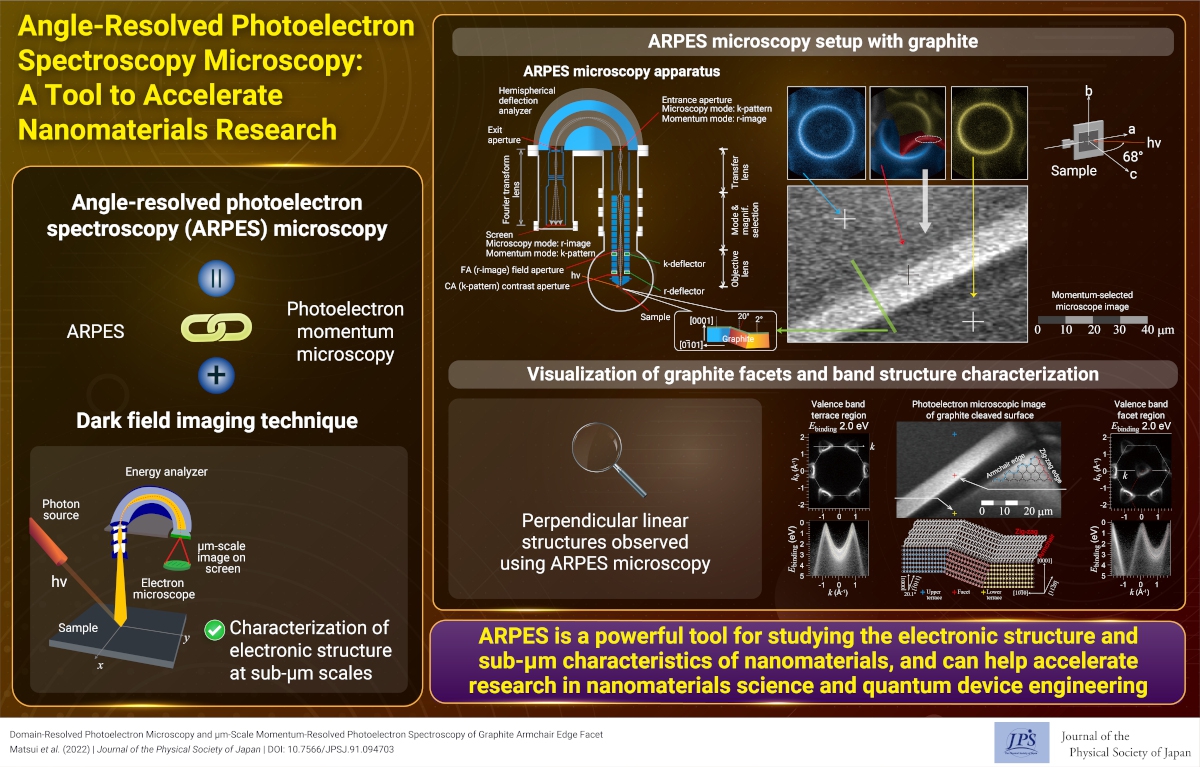Angle-Resolved Photoelectron Spectroscopy Microscopy: A Tool to Accelerate Nanomaterials Research
© The Physical Society of Japan
This article is on
Domain-Resolved Photoelectron Microscopy and µm-Scale Momentum-Resolved Photoelectron Spectroscopy of Graphite Armchair Edge Facet
(JPSJ Editors' Choice)
J. Phys. Soc. Jpn.
91,
094703
(2022)
.
Researchers have published a practical guide on new uses of photoelectron microscopy combined with valence band dispersion analysis. They visualized several-micrometers-wide graphite facets and precisely characterized the band structure.

In recent years, the integration of high-resolution spectroscopy and microscopic imaging has attracted considerable attention owing to the demand in the fields of materials science and device engineering to elucidate the atomic structure and valence electron behavior for determining the material properties of sub-μm-scale polycrystalline composites and highly integrated structures. Angle-resolved photoelectron spectroscopy (ARPES) measures the angular distribution (momentum space distribution) of photoelectrons emitted from the sample surface irradiated with X-rays and reveals the composition and electronic structure of the sample. Photoelectron emission microscopy (PEEM) captures photoelectrons using a cathode lens and projects a magnified real-space image of the photon-irradiated region onto a two-dimensional detector. Photoelectron momentum microscopy (PMM) is a new type of PEEM that has greatly improved the projection range in the momentum space as well as the energy resolution and facilitates ARPES measurements in minute areas. In low-energy electron microscopy (LEEM) that uses electrons as the excitation source, a technique called dark-field imaging has been developed to select electron diffraction spots in momentum space and visualize the spatial distribution of specific domains. Recently, researchers at the UVSOR Synchrotron Facility in Okazaki have applied the LEEM dark-field imaging method to PMM and established a momentum-selective photoelectron microscopy method; this is a new development in microscopic ARPES measurements.
Figure 1 shows an example of a local electronic structure measurement on a graphite cleaved surface by PMM. When a hexagonal single-crystal graphite flake is viewed with an optical microscope, many lines perpendicular to the edges are observed. From the shape of the valence band dispersion, the crystal orientation and interlayer distance in the local region can be identified. The π-dispersion of the valence band of graphite is the strongest at the M saddle point in the Brillouin zone. By selectively measuring the photoelectron intensity in the M direction of each region, a photoelectron microscopic image showing each region with a contrast with a resolution of about 100 nm can be projected. This technique reveals perpendicular linear structures as twinned graphite domains formed by folding. This report describes the momentum-selective photoelectron microscopy technique in detail.
This momentum-selective photoelectron microscopy technique has been applied in the visualization of monolayer step edges on the graphite surface and domain observation of thin film growth. Future applications are expected to meet the demands of microscopic spectroscopy research in nanomaterials science and quantum device engineering.
(written by Fumihiko Matsui on behalf of all authors.)

Figure 1: (Center) Domain-selected photoelectron microscopic image and the atomic structure model of the facet structure on the cleaved graphite surface. Valence photoelectron patterns and band dispersions from (left) terrace and (right) facet regions are shown together.
Domain-Resolved Photoelectron Microscopy and µm-Scale Momentum-Resolved Photoelectron Spectroscopy of Graphite Armchair Edge Facet
(JPSJ Editors' Choice)
J. Phys. Soc. Jpn.
91,
094703
(2022)
.
Share this topic
Fields
Related Articles
-
Qualitative Changes in Kinetic Pathways Driven by Hydrodynamic Interactions in Dense Colloidal Suspensions
Cross-disciplinary physics and related areas of science and technology
Statistical physics and thermodynamics
Structure and mechanical and thermal properties in condensed matter
2025-4-18
Even in dense colloidal suspensions, where long-range hydrodynamic interactions are screened, near-field hydrodynamic interactions qualitatively influence the selection of kinetic pathways.
-
Higher-Order Topological Phases in Magnetic Materials with Breathing Pyrochlore Structures
Electronic structure and electrical properties of surfaces and nanostructures
Magnetic properties in condensed matter
Mathematical methods, classical and quantum physics, relativity, gravitation, numerical simulation, computational modeling
2025-4-7
A simple example of a higher-order topological phase, in which the symmetry decreases step-by-step from the bulk to the corner, is realized in a magnetic system with a pyrochlore structure and is characterized by a series of quantized Berry phases defined for the bulk, surface, and edge.
-
Exploring the Vibrant Interplay of Machine Learning and Physics
Cross-disciplinary physics and related areas of science and technology
Electron states in condensed matter
Elementary particles, fields, and strings
Mathematical methods, classical and quantum physics, relativity, gravitation, numerical simulation, computational modeling
Statistical physics and thermodynamics
Superconductivity
2025-3-13
This Journal of the Physical Society of Japan Special Topics edition explores how physics and machine learning complement each other and can solve unresolved problems in physics.
-
Bayesian Insights into X-ray Laue Oscillations: Quantitative Surface Roughness and Noise Modeling
Measurement, instrumentation, and techniques
Structure and mechanical and thermal properties in condensed matter
2025-2-14
This study adopts Bayesian inference using the replica exchange Monte Carlo method to accurately estimate thin-film properties from X-ray Laue oscillation data, enabling quantitative analysis and appropriate noise modeling.
-
Hyperuniform and Multifractal States in Bosonic Quasicrystalline Systems
Statistical physics and thermodynamics
Structure and mechanical and thermal properties in condensed matter
2025-2-10
Quantum states can be categorized as hyperuniform or multifractal based on electronic characteristics. This study demonstrates that bosonic quasicrystalline systems exhibit hyperuniform or multifractal quantum states.




